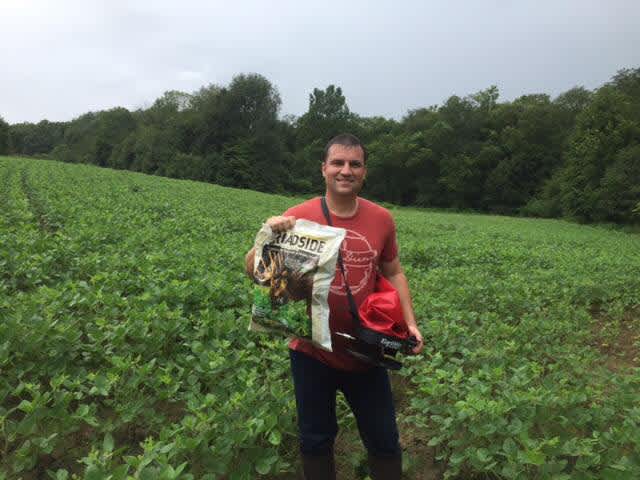Whitetail Wednesday: Don’t Clean the Table
Dave Maas 09.28.16

There is good chance of rain soon, so it will be time to do one of my favorite activities. I like to broadcast Broadside fall food plot blend into existing soybean plots. In a couple of the smaller food plots here at The Proving Grounds near Branson, Missouri, the deer have browsed the soybeans so aggressively that 30-50 percent of the soil is exposed to the sun. Deer are still using these food plots, so I don’t want to destroy the existing soybeans.
These bean fields are attracting and benefiting the deer. In fact, I might hunt over one of these plots soon. However, the soybeans in these plots won’t make enough pods to feed deer during the winter. Therefore, the “table” in these locations will be cleaned, and deer will feel unwelcome and probably go somewhere else to eat (maybe other properties).
Rather than clean the table, I simply start serving the next meal by walking through the plots and broadcasting the Broadside blend with a hand-operated spreader (photo below). The wheat, brassicas and radishes in this blend will germinate rapidly if it rains as forecasted. And the special soybeans in the blend are bred to germinate and grow quickly. These beans won’t survive after the first hard frost, but they are an incredible tasty appetizer to keep the deer feeding in this plot until the radishes, wheat and brassicas are large enough.

This plan keeps the deer foraging in the plot without interruption, and provides high-quality nutrition until spring when I’ll plant Eagle Seed forage soybeans again.
There’s another advantage that food plot farmers rarely talk about: Keeping forage growing year-round drastically reduces erosion and nutrient losses to leaching (fertilizer leaching too deep in the soil for plants to use). Radishes and turnips are very good at “mining” nutrients. That is to say, they capture nutrients in the deep roots and then bring them back to the surface. Either deer consume the nutrients (the purpose of the plot), or the big bulbs rot and provide them at the surface for the next crop.
This is the system that kept the great prairies extremely fertile for centuries. It’s an inexpensive and natural way to provide top-notch forage for deer at your proving grounds.
Enjoy creation!
Editor’s note: Be sure to check out Dr. Grant Woods and his popular on-demand web series that shares current information about deer hunting and deer management. The free videos focus on what the Growing Deer team of experienced hunters and deer managers are doing in the field week to week, including action-packed hunts, proven hunting strategies, habitat management, food plots, trail camera techniques and the gear it takes to get it all done.

